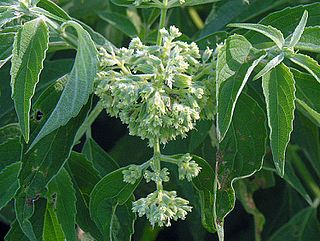
Psidium is a genus of trees and shrubs in the family Myrtaceae. It is native to warmer parts of the Western Hemisphere.

Pogonophora is a plant genus of the family Peraceae first described as a genus in 1854. It is native to central Africa and northern South America.
- Pogonophora letouzeyiFeuillet, 1993 - Gabon, Congo
- Pogonophora schomburgkianaMiers ex Benth., 1854 - Colombia, Venezuela, Guyana, Suriname, Fr Guinea, N + E Brazil
Erythrococca is a plant genus of the family Euphorbiaceae, first described in 1849. It is native to Africa and the Arabian Peninsula.
Mareya is a plant genus of the family Euphorbiaceae, first described as a genus in 1860. It is native to tropical western and central Africa.
Mareyopsis is a plant genus of the family Euphorbiaceae first described as a genus in 1919. It is native to western and central Africa.
- Mareyopsis longifolia(Pax) Pax & K.Hoffm. - Nigeria, Cameroon, Gabon, Equatorial Guinea, Congo-Brazzaville, Zaire
- Mareyopsis oligogynaBreteler - Gabon

Maprounea is a plant genus of the family Euphorbiaceae first named as a genus in 1775. It is native to tropical Africa, Trinidad, and tropical Central and South America.
- Maprounea africana - W + C + S Africa, from Benin to Zimbabwe
- Maprounea amazonica - Colombia, Venezuela, N Brazil
- Maprounea brasiliensis - Brazil, Paraguay, Bolivia
- Maprounea guianensis - Trinidad, Panama, Colombia, Venezuela, French Guiana, Suriname, Guyana, Brazil, Peru, Ecuador, Bolivia, Paraguay
- Maprounea membranacea - Nigeria, Cameroon, Gabon, Equatorial Guinea, Cabinda, Central African Republic, Congo, Zaire
Pseudosenefeldera is a plant genus of the family Euphorbiaceae first described as a genus in 2001. It contains only one known species, Pseudosenefeldera inclinata, native to Panama and to northern and west-central South America.

Tonina fluviatilis is a plant species in the Eriocaulaceae. It is the sole species in the monotypic genus Tonina, native to southern Mexico, Central America, northern South America, Cuba and Trinidad.

Renealmia is a plant genus in the family Zingiberaceae. Its members are native to tropical Africa and tropical America. In Peru, fruits and tubers are sources of indigenous dyes. and indigenous medical treatments for leishmania and malaria In Colombia, it is used to treat snakebite. Bracts and leaves can serve as phytotelmata, retaining small quantities of water that offer habitat for other organisms.
Eremospatha is a genus of climbing flowering plants in the palm family found in tropical Africa. These rattans are uncommon in cultivation and poorly understood by taxonomists;. Closely related to Laccosperma, they differentiated by the near complete absence of bracts and bracteoles. The name is from Greek meaning "without a spathe".

Lasimorpha is a monotypic genus of flowering plants in the family Araceae. The single species that makes up the genus is Lasimorpha senegalensis. This species is native to western and central Africa, from Liberia east to Chad and south to Angola.
Cyperus laxus is a sedge species in the Cyperaceae. It is native to tropical regions of the Western Hemisphere and also to Africa. The species is reportedly naturalized in Assam and the Andaman and Nicobar Islands.
Euterpe catinga is a palm species in the genus Euterpe. It is found in forests of a dry, sandy soil and very peculiar vegetation, known as catinga forests or Campinarana in northern South America.

Burmannia is a genus of flowering plants long thought of as related to orchids, although more recent studies suggest closer affinities with either the Dioscoreales or the Melanthiales. The plants are herbs, partially autotrophic (photosynthetic) but also partially parasitic on soil fungi.
Nietneria is a genus of plants in the Nartheciaceae. It has two known species, both native to northern South America.

Hoslundia is a genus of flowering plant in the family Lamiaceae, first described in 1804. It contains only one known species, Hoslundia opposita. It is widespread across much of sub-Saharan Africa including Madagascar.
Miersiella is a monotypic genus of flowering plants in the Burmanniaceae, first described as a genus in 1903. It contains only one known species, Miersiella umbellataUrb. It is native to South America.

Dictyostega is a genus of flowering plants in the Burmanniaceae, first described as a genus in 1840. It contains only one known species, Dictyostega orobanchoides, native to southern Mexico, Central America, Trinidad, and South America ).

Apteria is a genus of flowering plants in the Burmanniaceae, first described as a genus in 1834. It contains only one known species, Apteria aphylla, the nodding-nixie, native to the southern United States, Mexico, Central America, the West Indies, and South America.

Dimerocostus is a group of plants in the Costaceae described as a genus in 1891. It is native to Central and South America.











